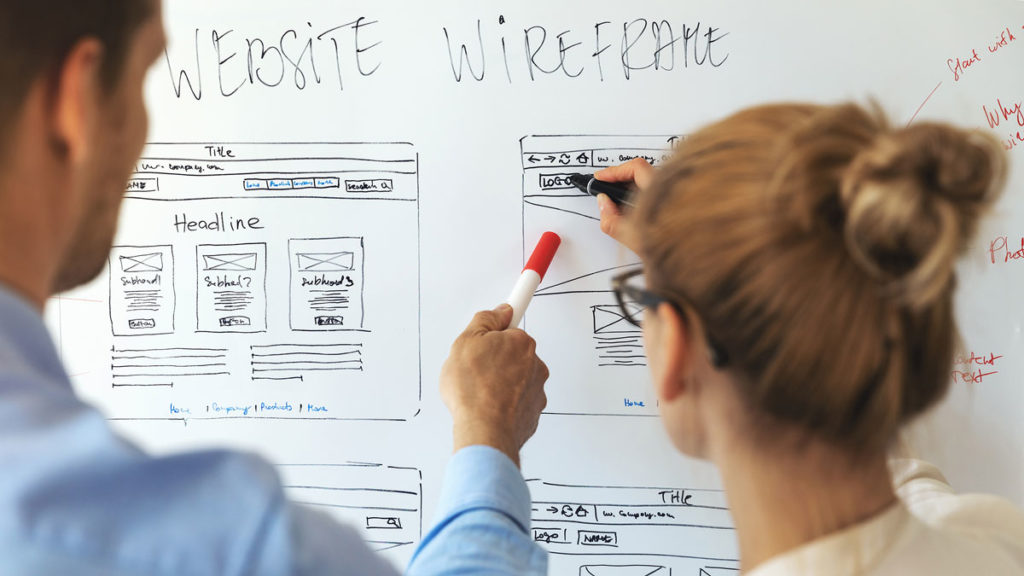Here in our small town of Rochester, Michigan, life is pretty simple. So when we design and develop web sites, we know it’s important to keep it simple for the site’s visitors. And that means creating a user interface and experience that is intuitive and logical, yet specifically designed to increase conversion rates.
Think of it like this:
You just bought a new house, and now you’re standing in your kitchen trying to decide the best areas to place your dishes, cups, pots and pans, silverware, and so on.
You think, “Hmm. My coffeemaker is going here, so let’s place the coffee mugs in the cabinet on top of it. As for the drinking glasses, let’s make it convenient for people to grab one to pour themselves a glass of water from the dispenser. Let’s place them in this cabinet here beside the refrigerator. As for the silverware, that should go in this drawer under the plates, and the plates should be placed near the stove for quicker plating.”
Logical, right? Even if your acquaintance has never, ever been in your home before, that person should be able to find exactly what they’re looking for easily — if you organized your kitchen just right. The right place should be the first place they look.
You don’t want your new friends to feel frustrated having to go through all your cabinets in order to find one little mug. They might give up on it altogether and head to the nearest convenience store to buy themselves that cup o’ joe … and who knows if you’ll see them again after that, right?
But you don’t want that (hopefully). You want your visitors to leave happy and looking forward to coming back. They should leave thinking, “They really know what they’re doing in the kitchen there. If how that kitchen is organized is any indication, I bet they’re great cooks. I hope they invite us over for dinner next time. Ha!”
Our point of the story?
All of these concepts apply to UI/UX in web design as we develop websites for businesses throughout Michigan. Here’s how.
1. The overall website should be organized so that users can easily find what they’re looking for. You don’t want them getting frustrated, leaving your site, and heading to another site. (Having coffee in your company is better than buying it at some convenience store, and they should experience that.)
2. The individual pages of the site and what you find on them should simply make sense. Like an old-fashioned print filing system, the pages on your site are grouped together in a way in which someone would know where to look to find what they’re looking for. (All the silverware goes in the same drawer, right?)
3. It’s easy to use the functionality throughout the site, such as forms or interactive infographics, as well as to navigate from one page to another. (No one spins in circles in your kitchen. No, sir, not on your watch.)
Among other factors, UI/UX is huge when it comes to how well your site will rank when compared with your competitors throughout metro Detroit. Search engines recognize when sites are set up properly and function optimally. We have that in mind as we design website structures as well as when we develop the hidden elements of your website.
Web designers also use UI/UX principles when designing various elements on the pages. The smarter the designs, the more likely those designs are to grab the attention of your visitors. Enticing images and CTAs are immensely important when it comes to conversion rates; the more eye-catching and interesting something is, the more likely someone is likely to take an action.
(And that’s true for just about anything in life. Why else would you buy pretty drinking glasses instead of the plain ones?)

What is UI/UX?
Both UI and UX apply to not only website development, but overall brand management as well. Although they are interchangeable and somewhat dependent upon each other, UI and UX are different.
User interface is based on interactions between users and computer systems, software, and applications. It’s made up of all the elements that enable someone to interact with a product or service. It’s about the presentation.
User experience is what a website visitor takes away from the website. A UX designer is responsible for researching, developing, and refining users’ experiences with a company and its website in order to ensure people find value from the brand.
In short: UI is about technical interactions. UX is about the experience as a whole.

The Elements of UI/UX in Web Design
Recommendations for UI/UX run the gamut. There is no cheat sheet. Success depends on the skill and ingenuity of the marketing agency you’re working with to build your website.
How UX is used in web design varies, but there are certain principles that apply across the board.
- The design should be contextual and act as a guide throughout the buyer journey.
- Set up your design in a manner that’s easy to navigate.
- Be approachable and human in text, designs, and one-on-one communication.
- Depending on the brand, provide enjoyable, easygoing experiences.
- Be to-the-point. While providing enough information to allow search engines to recognize you as an industry leader, you should remain succinct within the context. Don’t make your website visitors work too hard.
- The website should be responsive, functional, and beautiful whether users are looking at a mobile phone, laptop computer, or tablet, and that should be so regardless of the browser or the size of the device being used.
The same applies to user interface. Following are some of the elements of user interface that may be employed in web design:
- Informational components beyond basic text or images, such as notifications and message boxes, which can make a website more interactive
- Breadcrumbs, which visually show users where they are on a site
- Input controls, like dropdown lists and toggles, that give users an extra resource to find the information they need, which can be especially helpful for large entities such as hospitals
Looking for the Right Website Developer in Michigan to Build Your Brand?
Website design and development for the best user interface and user experience is not easy. It takes years of experience and testing to truly pinpoint what works and what doesn’t. Even then, it requires regular analysis and website updates for optimal results.
It’s a comprehensive perspective that fuses various factors and elements together with a goal of making the experience better for your prospects and more beneficial for you.
Based in Oakland County, Michigan, our marketing agency has been developing websites for more than 15 years and has a skilled team that can take your brand’s image to the next level. Contact our marketing agency, located in downtown Rochester, to see how we can use UI/UX in web design to elevate your brand.
